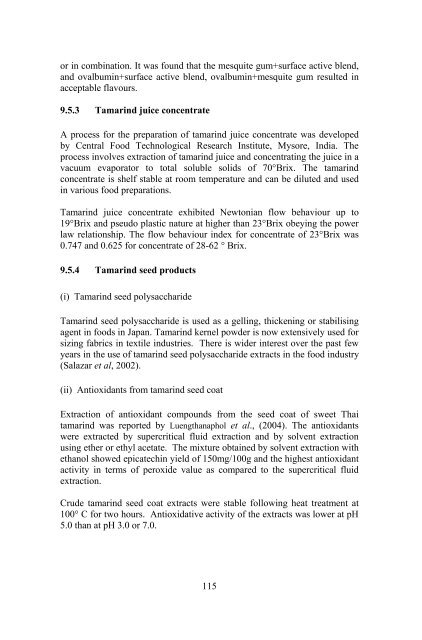Tamarind monograph.pdf - Crops for the Future
Tamarind monograph.pdf - Crops for the Future
Tamarind monograph.pdf - Crops for the Future
Create successful ePaper yourself
Turn your PDF publications into a flip-book with our unique Google optimized e-Paper software.
or in combination. It was found that <strong>the</strong> mesquite gum+surface active blend,<br />
and ovalbumin+surface active blend, ovalbumin+mesquite gum resulted in<br />
acceptable flavours.<br />
9.5.3 <strong>Tamarind</strong> juice concentrate<br />
A process <strong>for</strong> <strong>the</strong> preparation of tamarind juice concentrate was developed<br />
by Central Food Technological Research Institute, Mysore, India. The<br />
process involves extraction of tamarind juice and concentrating <strong>the</strong> juice in a<br />
vacuum evaporator to total soluble solids of 70°Brix. The tamarind<br />
concentrate is shelf stable at room temperature and can be diluted and used<br />
in various food preparations.<br />
<strong>Tamarind</strong> juice concentrate exhibited Newtonian flow behaviour up to<br />
19°Brix and pseudo plastic nature at higher than 23°Brix obeying <strong>the</strong> power<br />
law relationship. The flow behaviour index <strong>for</strong> concentrate of 23°Brix was<br />
0.747 and 0.625 <strong>for</strong> concentrate of 28-62 ° Brix.<br />
9.5.4 <strong>Tamarind</strong> seed products<br />
(i) <strong>Tamarind</strong> seed polysaccharide<br />
<strong>Tamarind</strong> seed polysaccharide is used as a gelling, thickening or stabilising<br />
agent in foods in Japan. <strong>Tamarind</strong> kernel powder is now extensively used <strong>for</strong><br />
sizing fabrics in textile industries. There is wider interest over <strong>the</strong> past few<br />
years in <strong>the</strong> use of tamarind seed polysaccharide extracts in <strong>the</strong> food industry<br />
(Salazar et al, 2002).<br />
(ii) Antioxidants from tamarind seed coat<br />
Extraction of antioxidant compounds from <strong>the</strong> seed coat of sweet Thai<br />
tamarind was reported by Luengthanaphol et al., (2004). The antioxidants<br />
were extracted by supercritical fluid extraction and by solvent extraction<br />
using e<strong>the</strong>r or ethyl acetate. The mixture obtained by solvent extraction with<br />
ethanol showed epicatechin yield of 150mg/100g and <strong>the</strong> highest antioxidant<br />
activity in terms of peroxide value as compared to <strong>the</strong> supercritical fluid<br />
extraction.<br />
Crude tamarind seed coat extracts were stable following heat treatment at<br />
100° C <strong>for</strong> two hours. Antioxidative activity of <strong>the</strong> extracts was lower at pH<br />
5.0 than at pH 3.0 or 7.0.<br />
115

















